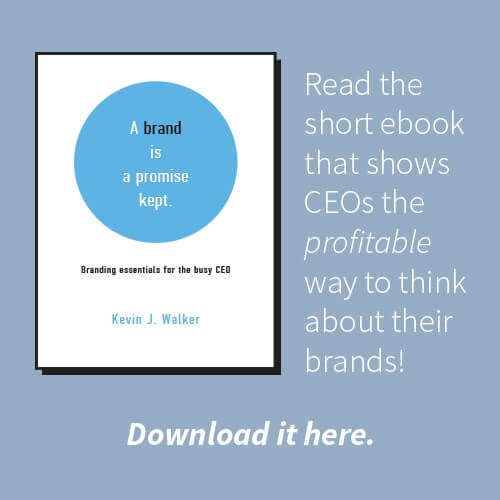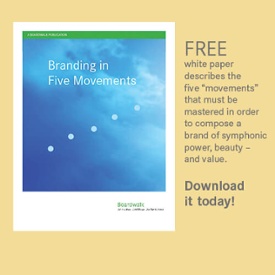 Back when I was first getting into the branding biz as a graphic designer, best practices insisted on a pretty rigid approach. A business should have one logo, one corporate color, one everything. And everything should be applied in exactly the same way, in every circumstance, every location. At the time, once a company was so branded, it was thought it would stay that way forever. Once it was done “right”, why should it ever have to be addressed again? Of course, times change, companies change and aesthetics change. So, of course, even legacy B2B brands like IBM and General Electric have, from time to time, adjusted their brand strategies. They’ve updated their corporate identities even more often. They do this to stay fresh and relevant in the eyes of their markets. Then, in the ‘80s, MTV introduced what would be known as the first identity “system”, one logo that was illustrated in countless ways. Breaking all the norms, MTV proved that a visual identity could be a living thing; it could change day to day and even have different moods. Today, many other visual identities are alive in that sense. There really are no rules anymore. That sets up an exciting environment for visual expression. But it’s one that can be damaging to many companies that aren’t prepared to manage the ensuing complexity.
Back when I was first getting into the branding biz as a graphic designer, best practices insisted on a pretty rigid approach. A business should have one logo, one corporate color, one everything. And everything should be applied in exactly the same way, in every circumstance, every location. At the time, once a company was so branded, it was thought it would stay that way forever. Once it was done “right”, why should it ever have to be addressed again? Of course, times change, companies change and aesthetics change. So, of course, even legacy B2B brands like IBM and General Electric have, from time to time, adjusted their brand strategies. They’ve updated their corporate identities even more often. They do this to stay fresh and relevant in the eyes of their markets. Then, in the ‘80s, MTV introduced what would be known as the first identity “system”, one logo that was illustrated in countless ways. Breaking all the norms, MTV proved that a visual identity could be a living thing; it could change day to day and even have different moods. Today, many other visual identities are alive in that sense. There really are no rules anymore. That sets up an exciting environment for visual expression. But it’s one that can be damaging to many companies that aren’t prepared to manage the ensuing complexity.
Organizations today can choose to adopt the rigid model for their brand identity. One look for all things and all purposes. Or they can opt for a more fluid system if that’s what would enable a stronger bond with their market. Here are some examples of how that might work.
 Back in the ‘60s, every McDonalds location looked exactly the same. They had a rigid approach to their branded architecture. Sloping roof punctured by two golden arches. Glass box counter area. No interior seating. No drive-thru window. Today, McDonalds come in all shapes and sizes, usually reflecting the aesthetics of the neighborhood – southwestern style in Tucson, mid-century modern in Palm Springs, etc. But they all still strongly communicate the McDonalds brand.
Back in the ‘60s, every McDonalds location looked exactly the same. They had a rigid approach to their branded architecture. Sloping roof punctured by two golden arches. Glass box counter area. No interior seating. No drive-thru window. Today, McDonalds come in all shapes and sizes, usually reflecting the aesthetics of the neighborhood – southwestern style in Tucson, mid-century modern in Palm Springs, etc. But they all still strongly communicate the McDonalds brand. Michael Beriut, of Pentagram, is a world-renown graphic designer who has created some brilliant identity systems. One of my favorites (this is my third time writing about it) is the system he developed for MIT Media Lab. The capital M and L at left may initially (pun absolutely intended) seem clumsy and awkward. But check out how it fits into a much larger system of brands and sub-brands. You’ll see the magic and how it all adds up to more than the sum of its parts.
Michael Beriut, of Pentagram, is a world-renown graphic designer who has created some brilliant identity systems. One of my favorites (this is my third time writing about it) is the system he developed for MIT Media Lab. The capital M and L at left may initially (pun absolutely intended) seem clumsy and awkward. But check out how it fits into a much larger system of brands and sub-brands. You’ll see the magic and how it all adds up to more than the sum of its parts.
Ask Boardwalk whether your
brand identity should be rigid or fluid.
 Consumer electronics manufacturer, Sonos, is also moving to a fluid system. Whereas most brand identities lean on one, maybe two, corporate colors, augmented by a palette of supporting colors, Sonos is ditching the corporate color altogether. They feel having a dominant corporate color is a “dated concept”. Instead, they’re using all the colors of their palette to create a look and feel that their market will recognize and appreciate.
Consumer electronics manufacturer, Sonos, is also moving to a fluid system. Whereas most brand identities lean on one, maybe two, corporate colors, augmented by a palette of supporting colors, Sonos is ditching the corporate color altogether. They feel having a dominant corporate color is a “dated concept”. Instead, they’re using all the colors of their palette to create a look and feel that their market will recognize and appreciate.  And some entertainment brands are taking the fluid system to a whole new level. Brands like Star Wars, Game of Thrones and others have incited such passion in their fan bases that the fans themselves are taking over branding duties. They’re writing fan fiction, inserting Luke Skywalker into entirely new adventures. They’re illustrating and posting other characters. They’re organizing cosplay events. They are actively participating in the brand life and influencing the brand itself. This is relatively new.
And some entertainment brands are taking the fluid system to a whole new level. Brands like Star Wars, Game of Thrones and others have incited such passion in their fan bases that the fans themselves are taking over branding duties. They’re writing fan fiction, inserting Luke Skywalker into entirely new adventures. They’re illustrating and posting other characters. They’re organizing cosplay events. They are actively participating in the brand life and influencing the brand itself. This is relatively new.
A brand is the relationship between a marketable asset and its market. The marketable asset determines what brand promise it can make to the market. It makes (communicates) that promise and then delivers on it consistently, over time. The market then rewards the marketable asset with brand loyalty. That’s how the covenant works. Until now, it fell to the marketable asset itself to manage the brand. Management determined how the trademarks were registered and applied. They determined corporate color and all the rest. Disney, Warner Bros. and the other entertainment giants got really accomplished at creating and managing their branded properties. Now they were facing amateurs coming along and weakening their work.
So at first the big entertainment studios fought against the fans interfering with their very rigid branding efforts. But how many cease-and-desist letters can you send out before recognizing that you’ve fallen victim to your own success? In the end, they’ve decided to live with the amateurs as long as they don’t monetize their activities.
So, as I said, this is an exciting time for visual expression. Marketers are only limited by their own imaginations. So where is that danger I mentioned?
Owners and managers of brands have to recognize that where a rigid system should always be designed by a professional graphic designer, fluid systems will require that designer’s continuing efforts. The project, in effect, never ends. McDonalds isn’t stamping out cookie cutter restaurants any more. They’re retaining architectural firms on an ongoing basis. Not cheap.
So before deciding to adopt a fluid brand identity system, one should ensure one has the budget to support it. The worst thing that can happen is to spend a lot of money developing the system, then be tempted, by fiscal worries, to cheat on it by hiring inexperienced talent to implement the various iterations down the road. Or worse, to manage it in-house with unqualified people. Or worse yet, to manage it as if it were a rigid system. That’s like going to the cineplex and only getting to see one frame of the movie. You might want your money back. Rigid or fluid, there’s no wrong choice. Fluid can be more engaging and more effective. But fluid requires more resources.
Best Branding Reads – Week of June 17, 2019
Caterpillar Digs Into Emotional Side Of B2B Marketing
Use the brand relationship to make that emotional connection.
How Millennials Are Changing The B2B Buyer Profile
Remember when the B2B buyer was a gruff old guy with an adding machine who sat at a steel desk in a windowless office? No more.
5 Brand Marketing Tips Every Brand Can Learn From the NBA
This sports league has done a lot right over the past couple of decades.
Solving Brand Challenges With The Paradox Process
When two opposing facts cannot both be true, you’re at the entrance to a creative breakthrough.
18 controversial moments in logo design and branding
Yes. Believe it or not, logos can get people pretty irritated. What’s your opinion?
New York City’s most chaotic design system is its most successful
Another example of a fluid brand identity system. This one, grown organically.
Brands Unite For Growth And Good
More and more, people are looking to brands, not governments, to change the world.



